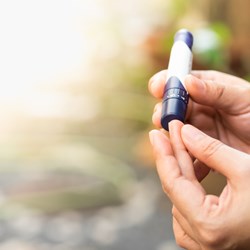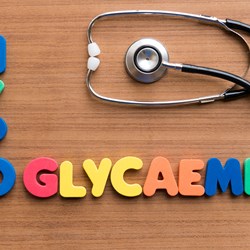Short Term Complications
Low Glucose
Hypoglycaemia (low blood glucose levels), more commonly known as a hypo, is when your blood glucose levels go low, typically below 4mmol/L. Only people using insulin or medications like gliclazide, glipizide, diamicron, glimepiride, glibenclamide are at risk of having hypos.
Symptoms
Everyone’s symptoms are slightly different, but the most common symptoms are trembling; sweating; becoming irritable or upset; going pale; lips tingling; blurred vision; confusion; tiredness and dizziness or a fast heartbeat. You should recognise the warning signs, act quickly, and tell your friends and family what to look out for.
Treating a hypo
To treat a hypo you should drink something sugary or eat 15-20g of a quick-acting carbohydrate such as 8 jelly beans or 4-6 glucose tablets, and follow on with some slow-release carbohydrate such as a banana or sandwich. You should recheck your blood glucose level after 10-15 minutes to make sure it has normalised. If someone has a severe hypo and has become unconscious, then contact the emergency services immediately.
High Glucose
Hyperglycaemia (high blood glucose levels) could be caused by illness, inactivity, missed treatment or higher carbohydrate intake.
Diabetic Ketoacidosis (DKA)
People with type 1 diabetes need to adjust their insulin levels in response to high glucose levels, otherwise, Diabetic Ketoacidosis (DKA) can occur. DKA is when your body doesn’t have enough insulin so it can’t use glucose as energy, and starts burning fat instead. The fat tissue produces an acidic substance called ketones, which if left untreated can build up in the bloodstream and can make you very ill.
Symptoms of DKA are normally extreme thirst; urinating more; tiredness; confusion; stomach pain; vomiting and/or diarrhoea; and strange taste and breath that smells like pear drop sweets. If you have type 1 diabetes, high glucose and tested positive for ketones then you should contact your diabetes team immediately (see sick day rules).
What can I do?
Both hypoglycaemia and DKA are serious conditions that need immediate action to prevent you from becoming very unwell. Testing your blood glucose levels regularly helps prevent both hypos and DKA.
Have a look at our resources below so you feel confident that you will be able to recognise the short-term complications you may experience, how you should treat them, what to do when you are ill and when you should seek medical help.
Register to access your GP health results
Looking for somewhere to record your daily blood glucose readings? If you have diabetes you can register to access your GP diabetes health results through our dashboard. You can also use this dashboard to record self-monitored results.
Advanced Search
Resource type -
Language -
Type of diabetes -
A low blood sugar, also called hypoglycaemia or a "hypo" is where the level of sugar (glucose) in your blood drops too low. In this video, healthcare professionals describe what hypoglycaemia is; how it is treated and what can cause it. You will also hear from people with diabetes describe their own…
This page explains what hypoglycaemia is and provides detailed information on the causes and symptoms of a hypoglycaemic episode (a 'hypo') and what you should do if you have one.
You must do something as soon as you notice symptoms of a hypo, or if a blood test has shown your blood glucose levels (also called blood sugar) is too low. If you don’t act quickly, it could get worse and you could start feeling confused and drowsy.
This resource tells you how to recognise when you have ketones in your blood and how these can cause diabetic ketoacidosis if left untreated.
This resource provides guidance for managing illness when using an insulin pump.
This resource explains what to do if you are unwell and have type 1 diabetes.
This page explains what to do if you are unwell and have type 2 diabetes.
Diabetic ketoacidosis (DKA) is a rare but serious condition. This leaflet is for people with type 2 diabetes that are on a group of medications called 'gliflozins' (Sodium glucose co-transporter-2 (SGLT2) inhibitors). These medications may increase your risk of DKA.
This course provides information about continuous glucose monitoring and the Freestyle libre. It is aimed at anyone diagnosed with type 1 diabetes that is using or would like to start using a continuous glucose monitor.
Flowchart for managing large (high) ketones when using a hybrid closed loop.
The Association of British Clinical Diabetologists (ABCD) sick day flowchart for users of hybrid closed loop.
TREND UK leaflet explaining what hypoglycaemia is, the warning signs of a hypo and how to treat it.













